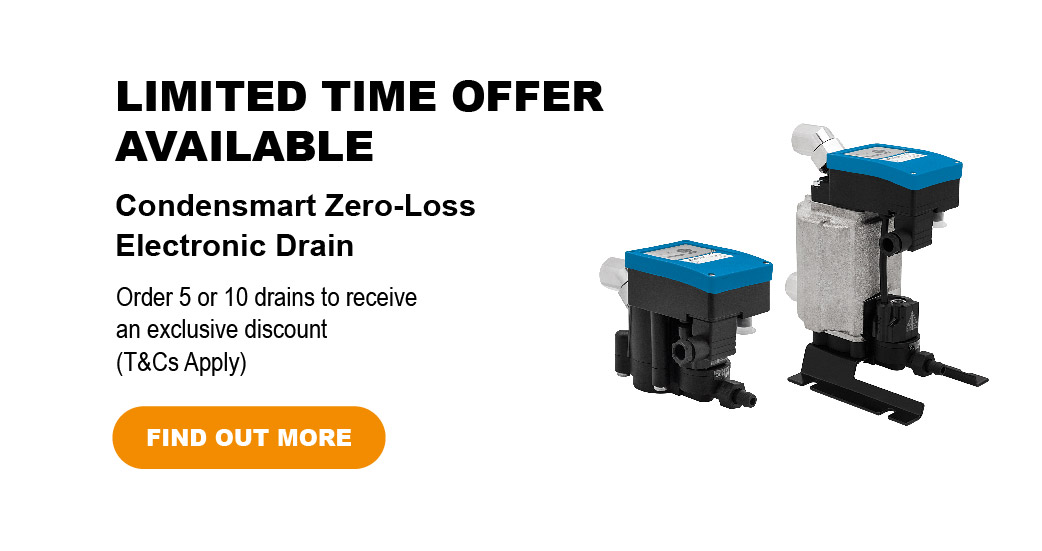The Importance of Zero-loss Electronic Drains
Posted on May 10th, 2022
Understanding the function, purpose, and benefits of implementing an electronic zero-loss drain within your compressed air system.
Compressed air, while useful to various industries and applications, relies heavily on systems that use oil in the production process. When oil particles escape the air-oil separator and enter the compressed air stream, cross-contamination between oil and water particles occurs. This droplet mixture can be potentially harmful to both the compressed air system and the environment. In many countries, including the United States, it is forbidden to dispose of condensate that is overly contaminated with oil particles. To address this issue, businesses turn to various condensate management products, including zero-loss electronic drains.
What is an electronic zero-loss drain?
To address this issue, businesses turn to various condensate management products. Though often overlooked, implementing the proper drain can elevate condensate treatment practises and protect your compressed air system. Generally, the implementation of any drain in a compressed air or vacuum system works to direct condensate away from the air stream and into an oil-water separator.
An electronic zero-loss drain, sometimes referred to as a zero-loss drain, an electronic drain or a no-loss drain, achieves the goal of diverting oil-water condensate away from the compressed air stream while eliminating compressed air leaks through automatic operation. The compressed air that is produced is then kept clean from oil, dirt, and other contaminants that would otherwise decrease its value and quality.
How does an electronic zero-loss drain operate?
Electronic zero-loss drains use sensory technology to identify the presence of condensate within the device. Condensate flows through the inlet valve of the device, where it fills the collection chamber until it hits its maximum capacity. Once the drain is at its maximum level, a contact float within the drain will rise and allow for condensate to drain and pass through the outlet of the device. However, the drain will always maintain a small amount of condensate at the bottom of the device for the valve to remain closed during its operation. This prevents both condensate crossover and compressed air leaks.
The Walker Filtration CondenSmart Zero-Loss Drain operates in a similar manner while utilising cutting-edge technology to improve the condensate management process. Because of the large condensate collection chamber and steady operating pressure, installing a zero-loss electronic drain can help eliminate the oil-water sheering that occurs in other drain models. An advanced microprocessor controls the valve operation in the device, allowing for more accurate condensate detection and evacuation. If too much condensate is present within the device and will not pass, the solenoid opens and closes itself automatically to release the blockage, preventing compressed air contamination or a system malfunction. At the outlet of the device, an additional strainer catches large particles that would otherwise disrupt proper drain function.
Low-Maintenance Operation
Electronic zero-loss drains are automatic and do not require an excess amount of costly external maintenance, especially in comparison to manual drain options. This makes for uninterrupted compressed air production. An automatic drain option creates more consistent performance conditions within your compressed air system. In turn, it is easier to detect the true energy consumption of your system.
Economically and Environmentally Sensible
It is important to consider the correlation between the environmental and economic impact that compressed air production has. Each year, facilities lose thousands of dollars to compressed air production inefficiencies and condensate mishandlings, leading to an increase in energy costs, end-product wastage, and environmental violations.
Proper condensate management is key to preventing avoidable compressed air production expenses. Although the upfront cost of purchasing the drain may be higher than other less technical options, the return on investment from installing an electronic zero-loss drain is usually visible within six months to a year, leaving a positive impact on both production costs and environmental compliance.
When paired with an oil-water separator, choosing an electronic zero-loss drain is particularly important to reducing the overall environmental and monetary impact of compressed air production. Improperly managed condensate with too high of an oil-concentration can lead to costly violations of environmental laws about wastewater disposal.
The Significant Impact of Compressed Air Leaks
If a compressed air leak is caused by an ineffective drain or a drain that does not guarantee zero compressed air loss, more energy must be exerted by the compressor to offset the loss. As a result, the compressor works harder to produce the same amount or less air that would be created had a zero-loss drain been installed. Installing an electronic zero-loss drain can actually help reduce energy usage due to the device requiring minimal energy for its operation. Because a zero-loss electronic drain stops compressed air leaks, the compressed air system can run at its optimum energy rate instead of using extra power.
Choose the Highest Quality Electronic Zero-loss Drain
Does your condensate management system need a new drain? Walker Filtration has a comprehensive line of electronic zero-loss drains that correspond with compressor flow rates ranging from 180 Nm3/min (106 SCFM) to 9600 Nm3/min (5650 SCFM).
Contact us at +44 (0) 191 417 7816 or sales@walkerfiltration.co.uk if you would like any further information on the CondenSmart Electronic Zero-loss Drain range.
